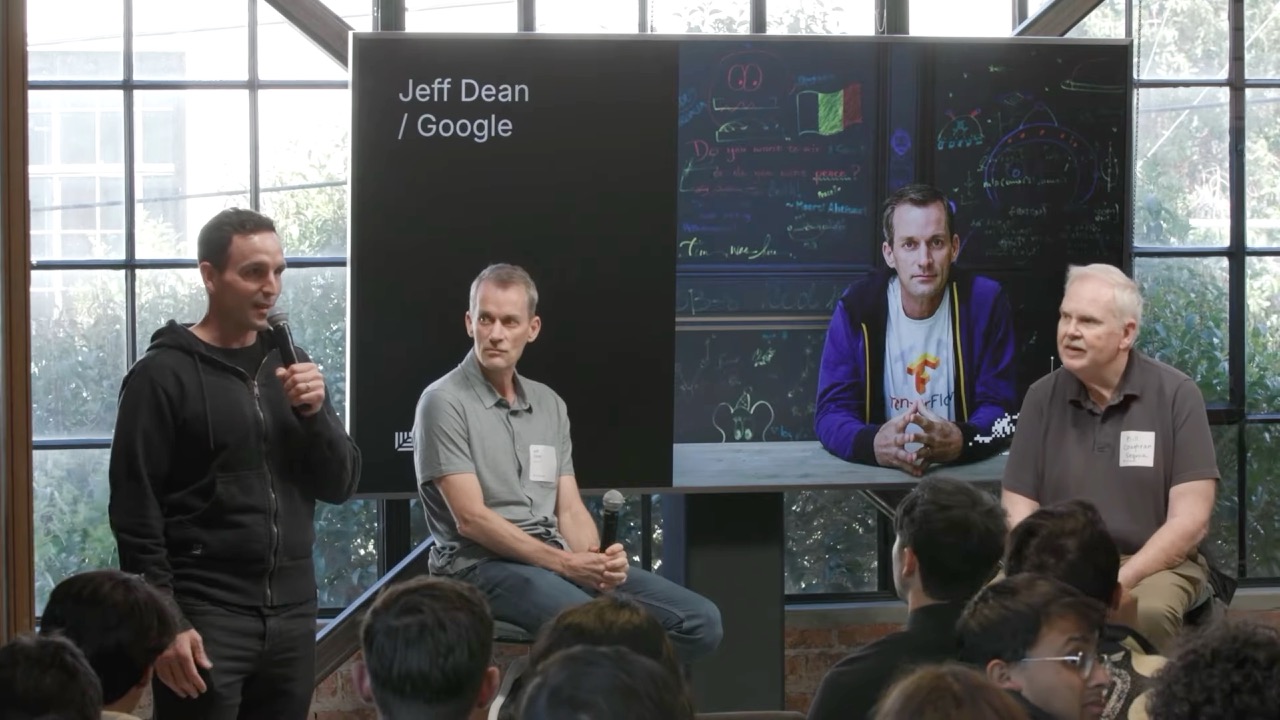AI Summary
At AI Ascent 2025, Google Chief Scientist Jeff Dean predicted that within roughly a year, AI systems could operate at the level of a junior engineer, capable of tasks beyond just coding, including testing, debugging, and learning from documentation. This aggressive timeline, coming from a leading figure in AI development, is based on the rapid evolution of large neural networks, specialized hardware like TPUs, and algorithmic improvements.
At AI Ascent 2025, Google's Chief Scientist Jeff Dean made a prediction that within a year, we could have AI systems operating continuously at the level of a junior engineer. This timeline, considerably more aggressive than many industry estimates, came from one of the most influential figures in AI, a pioneer whose work on Google's Tensor Processing Units (TPUs) and foundational research has helped shape modern AI.
Having overseen numerous transformative projects at Google, including the development of the BERT paper that helped spark the current AI revolution, Dean's predictions carry substantial weight. As Alphabet's Chief Scientist, he has a panoramic view of both Google's internal AI advancements and the broader industry landscape. His conversation with former Google engineering leader Bill Korn (now a partner at Sequoia) revealed a measured but optimistic view of AI's rapid acceleration.
From Transformers to Junior Engineers
Dean traced the evolution back to around 2012-2013, when researchers started applying large neural networks to solve complex problems in vision, speech, and language processing. What made this period revolutionary was that the same algorithmic approaches worked across these different domains.
"We trained a neural network that at the time was 60x larger than anything else," Dean recalled, describing Google's early scaling experiments. "We used 16,000 CPU cores because that's what we had in our data centers... and got really good results."
This experience cemented a principle that has guided AI development since: "Bigger model, more data, better results." While that principle remains largely true, Dean emphasized that algorithmic improvements have been equally or even more important than simply adding more hardware.
The 12-Month Horizon
When asked directly about the timeline for having an AI operating at the level of a junior engineer, Dean's response was surprisingly definitive: "Not that far... probably possible in the next yearish."
What makes this prediction particularly significant is that it doesn't refer to simple code generation but to a complete package of engineering skills. As Dean elaborated, this "hypothetical virtual engineer" would need more than just the ability to write code in an IDE:
- Running tests effectively
- Debugging performance issues
- Reading and applying documentation
- Learning from more experienced engineers
- Using various software development tools
The path to this capability, according to Dean, involves having these AI systems "reading documentation and sort of trying things out in virtual environments."
Beyond Just Code: The Full Engineering Experience
What distinguishes Dean's vision from current AI coding assistants is the comprehensive nature of the engineering work these systems would handle. Today's AI tools excel at generating code snippets or explaining existing code, but they typically lack the holistic understanding needed to function as true software engineers.
The key difference lies in the ability to integrate various aspects of software development—from understanding requirements to testing and debugging—in a coherent workflow. Dean's prediction implies AI systems that can maintain context across the entire development lifecycle, not just assist with isolated tasks.
This represents a significant leap from current capabilities, suggesting that the rapid advancement we've seen in AI coding assistants over the past year is accelerating even faster than public demonstrations have revealed.
Central to Dean's vision is the continued evolution of specialized AI hardware. Having helped bootstrap Google's TPU program in 2013, he has witnessed firsthand how purpose-built hardware transforms what's possible in AI.
"It's very clear that having hardware that is focused on sort of machine learning style computations... accelerators for reduced precision linear algebra are what you want," Dean explained. The first TPU generation focused on inference, while TPUv2 expanded to handle both inference and training.
This hardware specialization has enabled the training of increasingly sophisticated models. Google's latest TPU iteration, codenamed "Ironwood," is set to continue this trajectory, offering substantial performance improvements for both training and inference workloads.
The Shift Toward Brain-Inspired Computing
Moving beyond the rigid, homogeneous structures of current AI models, Dean advocated for "models that are kind of sparse and have different parts of expertise in different parts of the model."
He drew a compelling analogy to human cognition: "Our Shakespeare poetry part is not active when we're like worried about the garbage truck backing up at us in the car." This principle of specialized, context-dependent activation could lead to dramatically more efficient AI systems.
While Google has implemented some of these concepts through "mixture of expert" models, he believes we're "not really fully exploring the space yet." Current implementations use "incredibly regular" patterns of sparsity, whereas Dean envisions systems with much more varied computational pathways to create a much more organic continuous learning system than what we have today:
- Paths that are 100-1000x more computationally intensive than others
- Components with dramatically different compute requirements
- The ability to extend models with new parameters or compact existing sections through distillation
- Background processes that optimize memory usage, similar to garbage collection in programming languages
Agent Frameworks: Promise or Vaporware?
When questioned about the industry's current fascination with AI agents, Dean acknowledged both the promise and the current limitations. "I do see a path for agents with the right training process to eventually be able to do many things in the virtual sort of computer environment that humans can do today," he explained.
While he admitted that current agent implementations "can sort of do some things but not most things," he sees a clear development path through reinforcement learning and accumulated agent experience. Dean extended this vision to physical robotic agents as well, suggesting that within "the next year or two they'll start to be able to do 20 useful things" in messy, real-world environments.
This progression would follow a familiar pattern in technology: initially expensive products with limited capabilities, followed by cost engineering that dramatically reduces prices while expanding functionality.
The Model Landscape: How Many Players?
On the question of how many major AI model providers will survive, Dean was pragmatic. "Clearly it takes quite a lot of investment to build the absolute cutting edge models," he noted. "There won't be 50 of those. There may be like a handful."
However, he also highlighted the importance of techniques like distillation (which Dean co-authored a paper on in 2014, initially rejected as "unlikely to have impact"). These approaches allow lighter-weight, specialized models to be created from those cutting-edge systems, which could support "quite a number of different players in this space."
The distillation approach reflects a theme throughout Dean's perspective: the most powerful AI systems won't necessarily be the largest, but rather those that most efficiently deploy computation where and when it's needed.
What This Means for Developers
If Dean's prediction proves accurate, the software development landscape could undergo a significant transformation within the next year. Rather than replacing developers, these AI junior engineers would likely serve as force multipliers, handling routine tasks while allowing human engineers to focus on more creative and strategic work. For current developers, this suggests several priorities:
- Strengthening skills in areas where humans still maintain advantages, such as understanding business context and user needs
- Developing effective collaboration patterns with AI systems
- Learning to oversee and review AI-generated solutions
- Focusing on system architecture and design decisions that guide AI implementation
The rapid timeline also raises questions about how educational institutions and training programs should adapt. If AI can perform at a junior engineer level within a year, the entry path into software development careers may need significant recalibration.
Recent Posts













